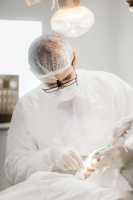
15 Oct Surgical Procedures That Generate Aerosols Requiring Enhanced PPE
MedicalResearch.com Interview with:
Sebastian Straube, BM BCh, MA (Oxon), DPhil
Professor and Director, Division of Preventive Medicine, Department of Medicine
University of Alberta
Zone Section Chief, Occupational Medicine Edmonton Zone, Alberta Health Services
Director, Foundation Course in Occupational Medicine
 MedicalResearch.com: What is the background for this study?
MedicalResearch.com: What is the background for this study?
Response: In view of the COVID-19 pandemic, medical procedures that generate aerosols require a higher grade of personal protective equipment, typically including filtering facepiece respirators (e.g. N95 masks). We wanted to know which procedures were aerosol-generating and would require such enhanced precautions.
MedicalResearch.com: How did you approach that question?
Response: We conducted a systematic review of the literature and aimed to find those procedures for which there is widespread agreement that they are aerosol-generating. We assembled a team of researchers with expertise in the subject matter as well as in systematic review methodology, and we searched widely for relevant guidelines, policy documents, and academic papers.
MedicalResearch.com: What are the main findings?
Response: Procedures classified as aerosol-generating or possibly aerosol-generating by at least 90% of the documents we identified – which we took to mean very strong consensus – include autopsy, surgery/postmortem procedures with high-speed devices, intubation and extubation procedures, bronchoscopy, sputum induction, manual ventilation, airway suctioning, cardiopulmonary resuscitation, and tracheostomy, among others.
MedicalResearch.com: What is the impact of your work?
Response: We hope that the results of our study will be considered by policy makers and guideline developers and will be incorporated into guidance documents. By that means, we hope that our work will ultimately help to keep health care workers safe, and thereby also contribute to keeping health care systems operational.
MedicalResearch.com: What recommendations do you have for future research as a result of this work?
Response: For some procedures, such as nasopharyngeal and oropharyngeal swabbing, there was disagreement between the source documents as to whether these procedures are aerosol-generating. More research work needs to be done for the procedures where there is such disagreement.
MedicalResearch.com: Is there anything else you would like to add?
Response: We are grateful to the Workers’ Compensation Board of Alberta, whose funding made this research work possible.
Citations:
Tanya Jackson, Danika Deibert, Graeme Wyatt, Quentin Durand-Moreau, Anil Adisesh, Kamlesh Khunti, Sachin Khunti, Simon Smith, Xin Hui S Chan, Lawrence Ross, Nia Roberts, Elaine Toomey, Trisha Greenhalgh, Isheeta Arora, Susannah M Black, Jonathan Drake, Nandana Syam, Robert Temple, Sebastian Straube. Classification of aerosol-generating procedures: a rapid systematic review. BMJ Open Respiratory Research, 2020; 7 (1): e000730 DOI: 10.1136/bmjresp-2020-000730
[wysija_form id=”3″]
[last-modified]
The information on MedicalResearch.com is provided for educational purposes only, and is in no way intended to diagnose, cure, or treat any medical or other condition. Always seek the advice of your physician or other qualified health and ask your doctor any questions you may have regarding a medical condition. In addition to all other limitations and disclaimers in this agreement, service provider and its third party providers disclaim any liability or loss in connection with the content provided on this website.
Last Updated on October 15, 2020 by Marie Benz MD FAAD
